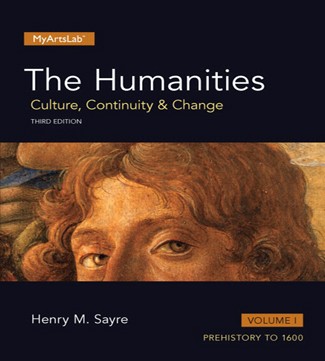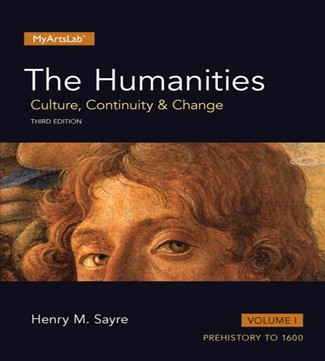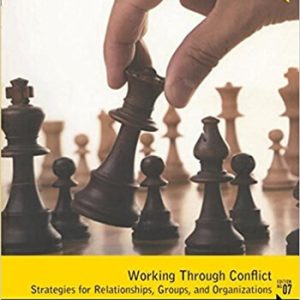Instant download The Humanities Culture Continuity and Change Volume 1 3rd Edition Sayre Test Bank pdf docx epub after payment.
Chapter 1: The Rise of Culture: From Forest to Farm
Multiple-Choice Questions
- Paleolithic cave paintings may have been intended to do all of the following EXCEPT
- serve as magic charms to ensure successful hunting.
- function as lunar calendars, predicting seasonal migration of the animals.
- conjure game by depicting it.
- commemorate the dead buried in the caves.
Answer: d page 4 LO: 1.1
- Why are the Chauvet animal paintings probably NOT associated with the hunt?
- Most of the animals painted on the walls were imaginary.
- Less than half of the animals painted on the walls are believed to have been hunted.
- Few of the animals painted on the walls were domesticated.
- Most of the animals painted on the walls were shown killing humans.
Answer: b page 4 LO: 1.1
- Why did the Chauvet painters utilize perspectival drawing?
- to convey a sense of three-dimensional space
- to demonstrate allegiance to the Mother Goddess
- to foster a sense of communal history
- to increase contrasts in values and color
Answer: a page 5 LO: 1.1
- Which of the following statements reflects the changed thinking regarding prehistoric art due to the discovery of Chauvet Cave?
- Art progressed from awkward beginnings to increased sophistication.
- The Paleolithic art in each cave probably was created by a single person.
- Art did not necessarily evolve in a linear progression from its early days in prehistory.
- Paleolithic cave art was a form of graffiti created by young people.
Answer: c page 5 LO: 1.1
- Among prehistoric paintings, what is distinctive about the painting of a bird-headed man, a bison, and a rhinoceros in Lascaux Cave?
- It includes a representation of a large animal.
- It is one of the few cave paintings to depict a human.
- It is painted on limestone.
- It demonstrates a rejection of naturalistic representation.
Answer: b page 5 LO: 1.1
- Why do Paleolithic female figurines vastly outnumber those representing males?
- Males were likely the carvers.
- Males probably outnumbered females.
- Females played a central role in the culture.
- All prehistoric gods were female.
Answer: c page 6 LO: 1.1
- Venus of Willendorf’s original red color is suggestive of
Answer: b page 6 LO: 1.1
- Implying a community’s sense of historical continuity, what was buried beneath some of the Neolithic Çatalhöyük houses?
- human bodies and skulls
- fertility goddess statuettes
- boar tusks, vulture skulls, and weasel teeth
- large terracotta heads of leaders
Answer: a page 8 LO: 1.2
- Why did the Neolithic era witness increased pottery creation?
- More permanent settlements could support artists.
- Tending crops provided more free time for art than hunting did.
- Neolithic people had learned to control fire for use in kilns.
- Fragile pottery was impractical for Paleolithic hunter-gatherers.
Answer: d page 11 LO: 1.2
- Why can the potter’s wheel be considered one of the first mechanical and technological breakthroughs in history?
- It allowed artisans to produce uniformly shaped vessels in short periods of time.
- It provided an alternative to creating vessels by casting metal.
- It enabled clay to be fired to a hot enough temperature to be hardened.
- It created an adequately smooth surface for pots to be painted.
Answer: a page 12 LO: 1.2
- Neolithic Nok heads have an artistry based upon
- animal imagery.
- burial masks.
- woven patterns.
- abstract geometrical shapes.
Answer: d page 13 LO: 1.2
- According to the most recent discoveries, Stonehenge was constructed as a
- sacrificial altar.
- royal residence.
- burial ground.
Answer: c page 16 LO: 1.2
- What is the most basic architectural technique for spanning space?
- post-and-lintel
- corbel
- cromlech
- menhir
Answer: a page 18 LO: 1.2
- What can myths tell about their cultures?
- place of origin
- views and beliefs
- social hierarchy
- form of government
Answer: b page 18 LO: 1.3
- The Anasazi built their kivas with a small, round hole in the floor to
- represent a belief that their ancestors emerged from the depths of the Earth.
- collect what little rain fell in the parched desert.
- demonstrate a belief that evil spirits could be flushed into the depths of the Earth.
- dispose of human waste and other refuse.
Answer: a page 21 LO: 1.3
- In the Zuni emergence tale, the Pueblo people originated in
- clay mounds formed by Himura, the potter goddess.
- the womb of Mother Earth.
- tears falling from the Sun Father’s eyes.
- the Spruce Tree House
Answer: b page 21 LO: 1.3
- Which of the following beliefs is NOT reflected in Pueblo emergence tales?
- The forces of nature are inhabited by living spirits.
- Humans can communicate with natural spirits.
- Humans can take on animal form if they offer proper sacrifices.
- Nature’s behavior can be compared to human behavior.
Answer: c page 22 LO: 1.3
- Japanese emperors claimed divinity as
- heads of the Shinto religion.
- direct descendants of the sun goddess.
- authors of the Kojiki.
- Manifestations of future kami.
Answer: b page 22 LO: 1.3
- The Shinto main sanctuary at Ise is always built of wood to
- demonstrate reverence for the natural world and tradition.
- avoid the cost of stone.
- deter the kami.
- effectively insulate against a cold climate
Answer: a page 23 LO: 1.3
- The Ise shrine is razed and then rebuilt every 20 years to
- prevent deterioration of its materials.
- ritually celebrate renewal.
- demonstrate disinterest in the material world.
- symbolize the lifespan of the goddess Amaterasu.
Answer: b page 23 LO: 1.3
- In prehistoric times, communication with the spiritual world is thought to have been largely conducted in
- semi-permanent huts.
- river valleys.
Answer: d page 24 LO: 1.4
- The Olmec’s giant mounds where the priests dwelled are thought to have possibly represented
- pregnant wombs,
- female breasts.
Answer: a page 24 LO: 1.4
- Why might the Olmec have carved their leaders’ heads in colossal size?
- to intimidate potential attackers away from their sacred sites
- to show the leaders as larger than life, like the gods
- to provide supports for their sacred sites’ roofs
- to serve as markers for the leaders’ graves
Answer: b page 24 LO: 1.4
- What do the Hopewell culture’s elaborate burials tell about them?
- They considered bear teeth sacred.
- They created beautiful works of pottery.
- They believed in reincarnation of the dead.
- They had an extensive trade network.
Answer: d page 25 LO: 1.4
- The Great Serpent Mound differs from most Hopewell mounds in its
- spiral shape and raised embankments.
- alignment with the sun at the equinoxes.
- absence of burial sites.
- mysterious abandonment.
Answer: c page 26 LO: 1.4
- With what astronomical event might the Great Serpent Mound be associated?
- the summer solstice
- Halley’s Comet
- a solar eclipse
- alignment of the planets
Answer: b page 26 LO: 1.4
Matching
- Chauvet Cave a. Scotland
- Venus of Willendorf b. Gulf of Mexico
- Stonehenge c. Ohio
- Nok d. American Southwest
- Skara Brae e. England
- Anasazi f. Austria
- Olmec g. France
- Great Serpent Mound h. Nigeria
Answers: 27-g (LO: 1.1), 28-f (LO: 1.1), 29-e (LO: 1.2), 30-h (LO: 1.2), 31-a (LO: 1.2), 32-d (LO: 1.3), 33-b (LO: 1.4), 34-c (LO: 1.4)
Essay Questions
- Discuss the implications of Chauvet Cave’s revelations about art not developing linearly and early Paleolithic artists not being as primitive as we previously thought. LO: 1.1
- Examine the Paleolithic female figurines—the Laussel Woman Holding an Animal Horn, the Venus of Willendorf—as “images of beauty in a cold, hostile world.” LO: 1.1
- Describe the picture of Paleolithic daily life that the human artifacts provide. LO: 1.1
- Discuss the view of society that construction of the megalithic dolmens, Carnac, and Stonehenge reveal. LO: 1.2
- Explain the reasons pottery making facilitated advancement for Neolithic agriculture-based people. LO: 1.2
- The indigenous Japanese religion of Shinto shares much with Pueblo religions. Compare the two on their emergence tales and their general beliefs about the gods and nature. LO: 1.3
- Describe the afterlife beliefs that the mound burials of the Hopewell people present. LO: 1.4






